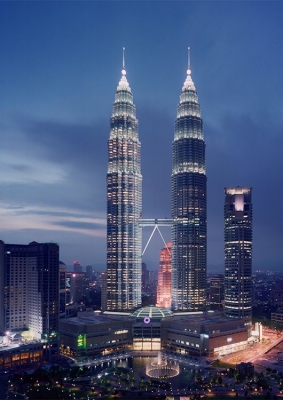
Petronas Twin Towers were once the tallest buildings in the world. Now the world’s tallest twin structures, the 88-storey buildings were designed by Cesar Pelli & Associates with both towers joined at the 41st and 42nd floors (175m above street level) by a 58 metre-long, double-decker Sky Bridge.
Standing 452 metres tall, the Petronas Twin Towers retained its world-title claim to fame until 2004 when Taipei’s 101 was built, measuring 508 metres tall. Today, the Burj Khalifa in Dubai (opened in 2010) retains the spot as the world’s tallest building. Located in the KL city centre, the Petronas Twin Towers’ architecture is Islamic-inspired and the buildings primarily house the corporate headquarters of the Petronas Company and other offices.
The towers were designed by Argentine architect César Pelli. A distinctive postmodern style was chosen to create a 21st-century icon for Kuala Lumpur, Malaysia. Planning on the Petronas Towers started on 1 January 1992 and included rigorous tests and simulations of wind and structural loads on the design. Seven years of construction followed at the former site of the original Selangor Turf Club, beginning on 1 March 1993 with excavation, which involved moving 500 truckloads of earth every night to dig down 30 metres (98 ft) below the surface.
Due to the huge cost of importing steel, the towers were constructed on a cheaper radical design of super high-strength reinforced concrete. High-strength concrete is a material familiar to Asian contractors and twice as effective as steel in sway reduction; however, it makes the building twice as heavy on its foundation as a comparable steel building. Supported by 23-by-23 metre concrete cores and an outer ring of widely spaced super columns, the towers use a sophisticated structural system that accommodates its slender profile and provides 560,000 square metres of column-free office space. Below the twin towers is Suria KLCC, a shopping mall, and Petronas Philharmonic Hall, the home of the Malaysian Philharmonic Orchestra.
Picture Credit : Google

